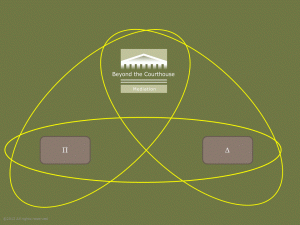Mediation: Something in the Middle
For people to reach their solutions, something needs to be different. And Now for Something Completely Different. One of the biggest differences you can make in a dispute is simply to get a mediator involved.
Having a someone else there definitely makes things different. Having a third person there who’s not invested in the dispute and who doesn’t have a dog in the fight or a stake in the result can sometimes make all the difference in the world.
Just the fact that somebody else is there is sometimes all it takes. Sometimes it takes more.
There are times, after a mediation, I think there wasn’t a danged thing I did to help other than just being there. I just watched it happen. And that’s okay.
Some mediators call this is the “magic of mediation:” that two people who were at loggerheads can sit in a room with a mediator present and come to their own resolution when they couldn’t before.
I don’t want to downplay the value of simply having an impartial third person’s presence – just having another person may be all you need. Maybe you don’t need the third person to be in there in it with you, helping you work you way through it. But sometimes you do. And sometimes a bit more is necessary. Sometimes a lot more.
Conflict is a powerful dynamic between people. They’ve developed patterns of interacting with each other that are amazingly predictable. They have well-worn paths of communication that, no matter where they start, always lead them to the same unworkable place.
Mediation comes from mediare, meaning being in the middle. Something gets right into the middle of it all between you and the people you’re in conflict with. That something is me.
 Now with me in the middle, there are three of us. Where there were two people in conflict, the network has three nodes now. Where there was a single system of two, there is now a complex system comprising three different two-person sub-systems:
Now with me in the middle, there are three of us. Where there were two people in conflict, the network has three nodes now. Where there was a single system of two, there is now a complex system comprising three different two-person sub-systems:
- The two people in dispute
- One person and the mediator
- The other person and the mediator
If there are more than two people involved, the number of subsystems expands exponentially.
Two people in dispute without a mediator – the two-node conflict network system – is ironically one of the most stable and powerful relationships there is. As the mediator, becoming the third node in the network, it can take a whole lot of energy just to loosen things up a little. It takes a lot of work to help them get off the well-worn unworkable paths and out of the predictable patterns of destructive interactions. That’s my job: to destabilize the unproductive, destructive conflict relationship.
I’m constantly monitoring these subsystems and intervening to affect the dynamics within them. I’m watching for opportunities to change the conflict system dynamic so they can see new ways of interacting with each other.
Why do I do this? So you can make conscious choices to work together into a solution-oriented interaction that is constructive and productive. So you can find the sustainable solution that works for both of you.


